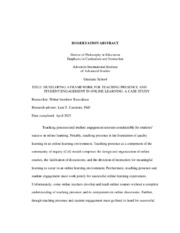| dc.description.abstract | Teaching presence and student engagement account considerably for students’
success in online learning. Notably, teaching presence is the foundation of quality
learning in an online learning environment. Teaching presence as a component of the
community of inquiry (CoI) model comprises the design and organization of online
courses, the facilitation of discussions, and the direction of instruction for meaningful
learning to occur in an online learning environment. Furthermore, teaching presence and
student engagement must work jointly for successful online learning experiences.
Unfortunately, some online teachers develop and teach online courses without a complete
understanding of teaching presence and its components in online classrooms. Further,
though teaching presence and student engagement must go hand in hand for successful
learning to occur, there is a need to investigate how the two constructs are established and
contribute to successful online learning.
This qualitative case study aimed to explore the perceptions of online teachers and
students on teaching presence and student engagement in an online learning environment
and to discover practical ways teachers establish affective teaching presence for
successful learning to occur in asynchronous and synchronous online courses.
Furthermore, the motivation of students to engage in online learning activities, the
challenges related to teaching presence, and student engagement were targeted in this
study. Finally, a framework for teaching presence and student engagement was designed.
Data was gathered through observations, in-depth interviews, focus group discussions
(FGD), and document analysis. This study was conducted at one university. A total of 30
participants, composed of 7 teachers and 23 online students, participated in the study.
Findings revealed that teaching presence is perceived as planning for online instruction,
facilitating discussions, and directing instruction. Further, student engagement was
perceived as participating actively in online learning activities and fulfilling the course
requirements promptly.
Furthermore, results revealed that personal characteristics, constructive feedback,
and effective use of educational technology tools are effective through which teachers
establish teaching presence. Additionally, different reasons motivate students to engage
in online courses. Hurdles and impediments were identified as challenges teachers and
students faced, and coping mechanisms were proposed. Finally, a framework is presented
as the final product of the study. As part of the conclusion, implications of the study and
recommendations to the administrators, teachers, and online students were provided. | en_US |

